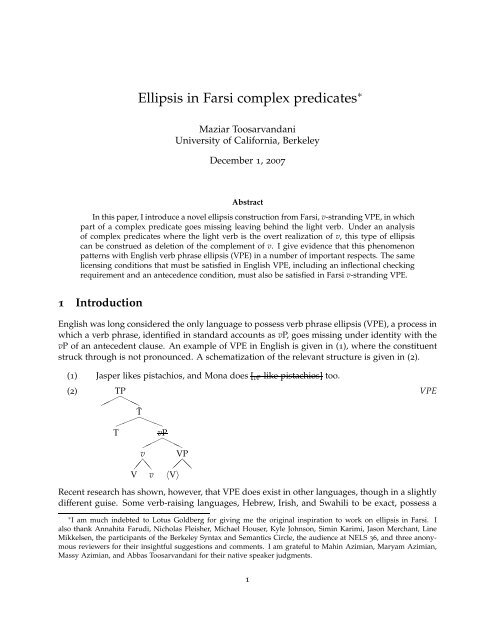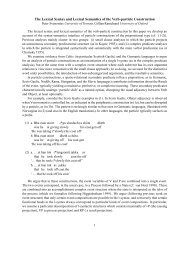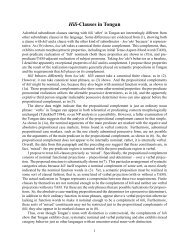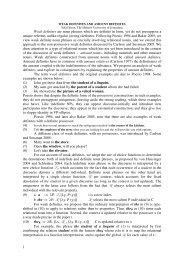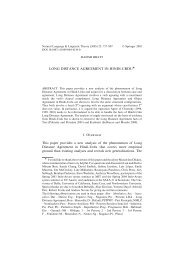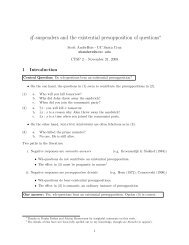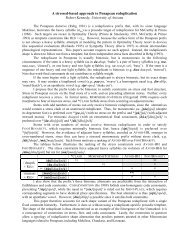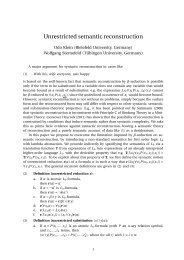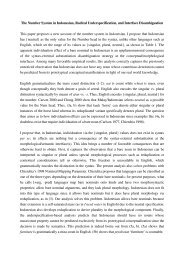Ellipsis in Farsi complex predicates
Ellipsis in Farsi complex predicates
Ellipsis in Farsi complex predicates
You also want an ePaper? Increase the reach of your titles
YUMPU automatically turns print PDFs into web optimized ePapers that Google loves.
<strong>Ellipsis</strong> <strong>in</strong> <strong>Farsi</strong> <strong>complex</strong> <strong>predicates</strong> ∗Maziar ToosarvandaniUniversity of California, BerkeleyDecember 1, 2007AbstractIn this paper, I <strong>in</strong>troduce a novel ellipsis construction from <strong>Farsi</strong>, v-strand<strong>in</strong>g VPE, <strong>in</strong> whichpart of a <strong>complex</strong> predicate goes miss<strong>in</strong>g leav<strong>in</strong>g beh<strong>in</strong>d the light verb. Under an analysisof <strong>complex</strong> <strong>predicates</strong> where the light verb is the overt realization of v, this type of ellipsiscan be construed as deletion of the complement of v. I give evidence that this phenomenonpatterns with English verb phrase ellipsis (VPE) <strong>in</strong> a number of important respects. The samelicens<strong>in</strong>g conditions that must be satisfied <strong>in</strong> English VPE, <strong>in</strong>clud<strong>in</strong>g an <strong>in</strong>flectional check<strong>in</strong>grequirement and an antecedence condition, must also be satisfied <strong>in</strong> <strong>Farsi</strong> v-strand<strong>in</strong>g VPE.1 IntroductionEnglish was long considered the only language to possess verb phrase ellipsis (VPE), a process <strong>in</strong>which a verb phrase, identified <strong>in</strong> standard accounts as vP, goes miss<strong>in</strong>g under identity with thevP of an antecedent clause. An example of VPE <strong>in</strong> English is given <strong>in</strong> (1), where the constituentstruck through is not pronounced. A schematization of the relevant structure is given <strong>in</strong> (2).(1) Jasper likes pistachios, and Mona does [ vP like pistachios] too.(2) TP✟ ❍❍✟✟ ❍¯T ❛❛❛✦ ✦✦T✟✟v✪✪ ❡ V vvP✟ ❍❍❍VP ❅〈V〉VPERecent research has shown, however, that VPE does exist <strong>in</strong> other languages, though <strong>in</strong> a slightlydifferent guise. Some verb-rais<strong>in</strong>g languages, Hebrew, Irish, and Swahili to be exact, possess a∗ I am much <strong>in</strong>debted to Lotus Goldberg for giv<strong>in</strong>g me the orig<strong>in</strong>al <strong>in</strong>spiration to work on ellipsis <strong>in</strong> <strong>Farsi</strong>. Ialso thank Annahita Farudi, Nicholas Fleisher, Michael Houser, Kyle Johnson, Sim<strong>in</strong> Karimi, Jason Merchant, L<strong>in</strong>eMikkelsen, the participants of the Berkeley Syntax and Semantics Circle, the audience at NELS 36, and three anonymousreviewers for their <strong>in</strong>sightful suggestions and comments. I am grateful to Mah<strong>in</strong> Azimian, Maryam Azimian,Massy Azimian, and Abbas Toosarvandani for their native speaker judgments.1
variety of VPE that is called V-strand<strong>in</strong>g VPE by Goldberg (2005b) <strong>in</strong> her extensive survey of thephenomenon (see also Doron 1999 for Hebrew, McCloskey 1991 for Irish, and Ngonyani 1996 forSwahili). In these language, only the <strong>in</strong>ternal arguments go miss<strong>in</strong>g, as shown schematically <strong>in</strong>(3), s<strong>in</strong>ce the ma<strong>in</strong> verb raises <strong>in</strong>to a higher functional projection before vP is deleted.(3) TP ✏✏✏ ✏ ¯T ❛❛❛✦ ✦✦T✱✱ ❧ Tv✜ ❭V v✧〈v〉vP❜❜ ✧VP✪✪ ❡❡〈V〉V-strand<strong>in</strong>g VPEThe existence of VPE <strong>in</strong> these languages suggests that it may occur <strong>in</strong> yet other languages aswell, though <strong>in</strong> a similarly nontransparent manner.In this paper, I exam<strong>in</strong>e an ellipsis construction found <strong>in</strong> <strong>Farsi</strong>, <strong>in</strong> which part of a <strong>complex</strong>predicate goes miss<strong>in</strong>g. As the construction is, to my knowledge, the first attested <strong>in</strong>stance ofellipsis target<strong>in</strong>g part of a <strong>complex</strong> predicate, the first aim of this paper is to contribute the basicdata to the general l<strong>in</strong>guistic knowledge base. In the example of the construction <strong>in</strong> (4), thenom<strong>in</strong>al component of the <strong>complex</strong> predicate, otu ‘iron’, goes miss<strong>in</strong>g along with the <strong>in</strong>ternalargument piranā-ro ‘the shirts’. 1(4) sohrāb piranā-ro otu na-zad vali rostam [piranā-ro otu] zad.Sohrab shirt.pl-obj iron neg-hit.past.3sg but Rostam shirt.pl-obj iron hit.past.3sg‘Sohrab didn’t iron the shirts, but Rostam did.’Follow<strong>in</strong>g Folli et al.’s (2005) analysis of <strong>Farsi</strong> <strong>complex</strong> <strong>predicates</strong>, I treat the light verb of the<strong>complex</strong> predicate as an overt v head. In this type of ellipsis, then, it is the complement of v, XP<strong>in</strong> (5), that is deleted. I call this type of ellipsis v-strand<strong>in</strong>g vpe.(5) vP❜❜ ✧✧¯v✚ ✚❩ ❩XP v✪ ❡Xv-strand<strong>in</strong>g VPEUnlike English, Hebrew, Irish, or Swahili, ellipsis <strong>in</strong> <strong>Farsi</strong> targets a constituent smaller than vP.My second aim is to show that v-strand<strong>in</strong>g VPE, despite show<strong>in</strong>g surface differences withEnglish VPE, does not differ significantly <strong>in</strong> its licens<strong>in</strong>g requirements. Just like English VPE,1 The abbreviations I use are: 1, first person; 2, second person; 3, third person; acc, accusative; adv, adverbialsuffix; F, fem<strong>in</strong><strong>in</strong>e; <strong>in</strong>ter, <strong>in</strong>terrogative; M, mascul<strong>in</strong>e; neg, negation; obj, <strong>Farsi</strong> differential object marker rā; part,participle; pl, plural; pres, present; sg, s<strong>in</strong>gular; subj, subjunctive.The judgments presented here were obta<strong>in</strong>ed from several native speakers of <strong>Farsi</strong> resid<strong>in</strong>g <strong>in</strong> Iran and the UnitedStates. Their speech represents the colloquial variety of the language spoken <strong>in</strong> Tehran. <strong>Farsi</strong> examples from othersources have been cited as such, though I have taken the liberty of retranscrib<strong>in</strong>g and regloss<strong>in</strong>g them.2
v-strand<strong>in</strong>g VPE requires: 1) the presence of an overt, tense <strong>in</strong>flect<strong>in</strong>g head (Zagona 1982, Lobeck1995), and 2) the satisfaction of an antecedence condition that enforces identity of the target andantecedent phrases, which I assume, follow<strong>in</strong>g much current research, to be Merchant’s (2001)e-givenness constra<strong>in</strong>t.This paper is structured as follows: First, <strong>in</strong> §2, I provide some background on the phrasestructure of <strong>Farsi</strong>. §3 advances the primary purpose of this paper, present<strong>in</strong>g the diagnostics thatshow that the gap <strong>in</strong> (4) is produced by the same process that derives English VPE. In §4, I showhow v-strand<strong>in</strong>g VPE obeys the same licens<strong>in</strong>g requirements as English VPE. In §5, I discuss anumber of problematic examples <strong>in</strong>volv<strong>in</strong>g light verb alternations that suggest, at least at first,that v-strand<strong>in</strong>g VPE might be constra<strong>in</strong>ed by additional requirements not found <strong>in</strong> English VPE.F<strong>in</strong>ally, <strong>in</strong> §6, I provide a short conclusion.2 <strong>Farsi</strong> phrase structure<strong>Farsi</strong> is a pro-drop language that allows scrambl<strong>in</strong>g but has basic SOV word order. Most of the<strong>predicates</strong> <strong>in</strong> the language are <strong>complex</strong> <strong>predicates</strong> comprised of two parts, a light verb and anonverbal element. The formation of <strong>complex</strong> <strong>predicates</strong> is productive and they comprise anever expand<strong>in</strong>g segment of the verbal system. The class of simplex verbs is mostly closed andnumbers some 115 members (Mohammad and Karimi 1992:195).The light verbs are homophonous with simplex verbs that bear a full, lexical mean<strong>in</strong>g (theheavy mean<strong>in</strong>g). A partial list of light verbs, glossed with their heavy <strong>in</strong>terpretations <strong>in</strong> smallcaps, is given <strong>in</strong> (6). The light verbs themselves do not contribute to the core semantics of<strong>complex</strong> <strong>predicates</strong>, though, as we will see, they play a crucial role <strong>in</strong> determ<strong>in</strong><strong>in</strong>g their argumentstructure.(6) a. kardan ‘to do’b. dādan ‘to give’c. zadan ‘to hit’d. gereftan ‘to take’e. keshidan ‘to pull’f. raftan ‘to go’g. āvordan ‘to br<strong>in</strong>g’h. bordan ‘to take’i. dāshtan ‘to have’j. shodan ‘to become’k. xordan ‘to eat’l. āmadan ‘to come’Possible nonverbal elements <strong>in</strong>clude nouns, 2 adjectives, and PPs, as illustrated <strong>in</strong> (7), (8), and (9)2 The reader may perhaps notice that many of the nom<strong>in</strong>al nonverbal elements are glossed with deverbal forms <strong>in</strong>English. This does not imply that these forms are deverbal <strong>in</strong> <strong>Farsi</strong>; most <strong>in</strong> fact are not. The source of nom<strong>in</strong>al nonverbalelements <strong>in</strong>cludes loanwords from Arabic and other languages, as well as nouns native to the language. Somenom<strong>in</strong>als formally resemble deverbal forms, but can only be considered such diachronically, as the verbs from whichthey are derived no longer exist. The nonverbal element gerye ‘cry<strong>in</strong>g’ (gerye kardan ‘to cry’) is derived historically3
espectively. The mean<strong>in</strong>g of the entire <strong>complex</strong> predicate is often idiomatic, e.g. (7a), though itcan also be quite transparent, e.g. (8a).(7) Nouna. chune zadanch<strong>in</strong> hit‘to barga<strong>in</strong>’b. edāme dādancont<strong>in</strong>uation give‘to cont<strong>in</strong>ue’(8) Adjectivea. bāz kardanopen do‘to open’b. bidār shodanawake become‘to wake up’(9) Prepositional Phrasea. betokār bordanwork take‘to be of use’b. az dast dādanfrom hand give‘to lose’The argument structure of <strong>complex</strong> <strong>predicates</strong> is highly predictable. The choice of light verbdeterm<strong>in</strong>es whether the <strong>complex</strong> predicate selects for an external argument or not. The m<strong>in</strong>imalpair <strong>in</strong> (10) displays a transitive-unaccusative alternation that is achieved solely by substitut<strong>in</strong>gone light verb for another. 3 The light verb zad ‘hit’ <strong>in</strong> (10a) selects for an external argument,rostam, while xord ‘ate’ <strong>in</strong> (10b) does not. The <strong>in</strong>ternal argument DP of laqat xordan ‘to getkicked’ is the subject and so cannot receive the differential object marker rā (realized as ro or o <strong>in</strong>the colloquial language). Nor can a different subject simply be <strong>in</strong>serted, as <strong>in</strong> (11).(10) a. rostam sohrāb-o laqat zad.Rostam Sohrab-obj kick hit.past.3sg‘Rostam kicked Sohrab.’b. sohrāb(*-o) laqat xord.Sohrab-obj kick eat.past.3sg‘Sohrab got kicked.’transitiveunaccusativefrom the simplex verb geristan ‘to cry’, which is no longer used <strong>in</strong> the colloquial language (hav<strong>in</strong>g been replaced bygerye kardan). The necessary translation of these nouns as deverbal forms is simply the result of these nouns be<strong>in</strong>g themore basic <strong>in</strong> <strong>Farsi</strong> and the opposite situation obta<strong>in</strong><strong>in</strong>g <strong>in</strong> English.3 As argued conv<strong>in</strong>c<strong>in</strong>gly by Moyne (1974), <strong>Farsi</strong> does not possess a passive construction. In the unaccusativeconstruction, the agent (if one exists) cannot be expressed except through extremely circumlocutous means.4
(14) rostam hamishe harf mizan-e vali sohrāb hichvaxt [ NP harf]Rostam always speech hit.pres-3sg but Sohrab never speechne-mizane.neg-hit.pres.3sg‘Rostam always talks but Sohrab never does.’(15) sohrāb piran-ā-ro otu na-zad vali rostam [ NP piranā-ro otu]Sohrab shirts.pl-obj iron neg-hit.past.3sg but Rostam shirts.pl-obj ironzad.hit.past.3sg‘Sohrab didn’t iron the shirts but Rostam did.’(16) rostam māsh<strong>in</strong>-esh-o be sohrāb neshun dādRostam car-his-obj to Sohrab show<strong>in</strong>g give.past.3sg[ NP māsh<strong>in</strong>-esh-o be sohrāb neshun] na-dād.car-his-obj to Sohrab show<strong>in</strong>g neg-give.past.3sg‘Rostam showed his car to Sohrab but Ram<strong>in</strong> didn’t.’valibutrām<strong>in</strong>Ram<strong>in</strong>Hav<strong>in</strong>g laid out the basic facts of <strong>Farsi</strong>, I now move on to diagnose the construction <strong>in</strong> (14–16) asa type of ellipsis.3 Diagnos<strong>in</strong>g ellipsis<strong>Ellipsis</strong> is dist<strong>in</strong>guished from other types of null anaphora by a number of well-established diagnosticsthat all rely on ellipsis be<strong>in</strong>g a type of surface anaphora <strong>in</strong> Hankamer and Sag’s (1976)terms. Surface anaphors have a fully articulated syntactic structure, constructed <strong>in</strong> the usualway, that is deleted under identity with a l<strong>in</strong>guistic antecedent at a later po<strong>in</strong>t <strong>in</strong> the derivation.Earlier work <strong>in</strong> the generative tradition achieved this through a transformation (Ross 1967), butmore recently, Merchant (2001) has argued that VPE, along with sluic<strong>in</strong>g, is derived by nonpronunciationof syntactic structure at PF. I will return to how this deletion is triggered formally, aswell as how the identity requirement is def<strong>in</strong>ed. First, however, I will show that <strong>Farsi</strong> v-strand<strong>in</strong>gVPE patterns with English VPE with respect to two diagnostics for surface anaphora that havebeen proposed <strong>in</strong> the literature: pragmatic control and extraction. 5(i)(ii)rām<strong>in</strong> be vis gol dād.Ram<strong>in</strong> to Vis flower give.past.3sg‘Ram<strong>in</strong> gave flowers to Vis.’rām<strong>in</strong> gol-o be vis dād.Ram<strong>in</strong> flower-obj to Vis give.past.3sg‘Ram<strong>in</strong> gave the flower to Vis.’Karimi (2005) offers an alternate <strong>in</strong>terpretation of these data <strong>in</strong> which all direct object DPs are merged as the complementof the nonverbal element or V. rā marked DPs subsequently raise to Spec-vP <strong>in</strong> order to check case, while bareobjects stay <strong>in</strong> situ, s<strong>in</strong>ce they do not bear case. I believe that v-strand<strong>in</strong>g VPE, as a test for constituency, will be useful<strong>in</strong> decid<strong>in</strong>g which of these two analyses is the correct one.5 Hankamer and Sag propose two additional tests for surface anaphora, the Miss<strong>in</strong>g Antecedent Phenomenon andsyntactic parallelism. I do not <strong>in</strong>clude these here s<strong>in</strong>ce their diagnostic abilities have been broadly challenged <strong>in</strong> theliterature.6
3.1 Pragmatic controlHankamer and Sag (1976) argue that the relationship between a surface anaphor and its antecedentis a syntactic one. VPE, as a type of surface anaphora, cannot have a purely contextualantecedent (it does not allow what they call pragmatic control), as illustrated <strong>in</strong> (17a). Deepanaphors like null complement anaphora, <strong>in</strong> contrast, receive their <strong>in</strong>terpretation <strong>in</strong> a discoursemodel, and so can have a purely pragmatic antecedent, as shown <strong>in</strong> (17b).(17) [Observ<strong>in</strong>g Hankamer attempt<strong>in</strong>g to stuff 12 ′′ ball through 6 ′′ hoop]Sag:a. # I don’t see why you even try to. VPEb. I don’t see why you even try. null complement anaphora(Hankamer and Sag 1976:414)Similarly, v-strand<strong>in</strong>g VPE does not allow pragmatic control, as illustrated <strong>in</strong> (18) and (19) forthe <strong>complex</strong> <strong>predicates</strong> jāru zadan ‘to sweep’ (lit. broom + to hit) and dush gereftan ‘to take ashower’ (lit. shower + to take). The nonverbal element and <strong>in</strong>ternal arguments cannot be elidedwith a solely nonl<strong>in</strong>guistic antecedent. 6(18) [Child picks up broom to sweep the carpet]Mother:a. motma’ensurebāshbexub farsh-o jāru be-zani.well carpet-obj broom subj-hit.2sg‘Be sure to sweep the carpet well.’b. # motma’ensurebāshbexub [ NP farsh-o jāru] be-zani.well carpet-obj broom subj-hit.2sg6 An anonymous reviewer po<strong>in</strong>ts out that Hankamer and Sag’s orig<strong>in</strong>al generalization has been questioned <strong>in</strong> theliterature start<strong>in</strong>g with Schachter 1977. In response, Hankamer (1978) and Pullum (2000) argue that all the exceptionsto the generalization might <strong>in</strong>stead be profitably analyzed as conventionalized collocations with nondeclarativeillocutionary force. More recently, Merchant (2004:716–732) abandons the view that surface anaphora cannot have anonl<strong>in</strong>guistic antecedent, but acknowledges that speakers’ judgments for examples like (17) vary (I personally f<strong>in</strong>dthe contrast to be quite strong). He accounts for the variability by posit<strong>in</strong>g the deep anaphor do it as the verb phrasethat has gone miss<strong>in</strong>g <strong>in</strong> (17a). Speakers differ as to how readily they accommodate the antecedent of do it so that VPEcan be licensed. See Sta<strong>in</strong>ton 2006:139–143 for a rebuttal of Merchant’s arguments with respect to fragment answers.A propos, while the judgments I obta<strong>in</strong>ed for the examples <strong>in</strong> (18–19) were strong, I have observed one <strong>in</strong>stance ofv-strand<strong>in</strong>g VPE without an apparent l<strong>in</strong>guistic antecedent:(i) A: ne-mixād bā man sohbat bokone?neg-want.pres.3sg with me speech subj.do.3sg‘Doesn’t he want to talk to me? I’m his son.’B: mixāy, bezan!want.pres.2sg imper.hit.2sgpesar-esh-am.son-his-am‘If you want to, call him!’ (Massy Azimian, January 19, 2007)What has ostensibly gone miss<strong>in</strong>g here is the nonverbal element of the <strong>complex</strong> predicate zang zadan ‘to call’ (lit.bell + to hit) and any <strong>in</strong>ternal arguments. The target clause <strong>in</strong> this example is a command, thus conform<strong>in</strong>g to thegeneralization of Hankamer and Pullum that cases of pragmatically controlled VPE always <strong>in</strong>volve nondeclarativeillocutionary force.7
(19) [Sohrab is gett<strong>in</strong>g ready to take a shower]Rostam (to Sohrab):3.2 Extractiona. ne-mituni dush be-giri chon āb nist.neg-can.pres.2sg shower subj-take.2sg s<strong>in</strong>ce water neg.is‘You can’t take a shower s<strong>in</strong>ce there isn’t any water.’b. # ne-mituni [ NP dush] be-giri chon āb nist.neg-can.pres.2sg shower subj-take.2sg s<strong>in</strong>ce water neg.isIf v-strand<strong>in</strong>g VPE is a surface anaphor like VPE then we expect to be able to extract from theelided constituent (Schuyler 2002). This is illustrated for English <strong>in</strong> (20), where an object DP, cake,has been topicalized.(20) Jason will eat shrimp, but squid, I know he won’t [eat 〈squid〉].In <strong>Farsi</strong> (a wh-<strong>in</strong> situ language), we can extract someth<strong>in</strong>g from the ellipsis site by scrambl<strong>in</strong>g theobject DP to a position <strong>in</strong> the matrix clause, where it receives a contrastive focus <strong>in</strong>terpretation(this parallels Schuyler’s observations for English), as illustrated <strong>in</strong> (21).(21) rostam PIRAN-O otu na-zade vali SHALVĀR-O midunam keRostam shirt-obj iron neg-hit.part.3sg but pants-obj know.pres.1sg that[〈shalvār-o〉 otu] zade.iron hit.part.3sg‘Rostam didn’t iron the shirt, but the pants, I know he did.’The scrambl<strong>in</strong>g can also be more local, as <strong>in</strong> (22), with a DP rais<strong>in</strong>g to a position just outside theelided constituent.(22) rostamRostamzade.hit.part.3sgPIRAN-Oshirt-objotu zadeva sohrāb SHALVĀR-O [〈shalvār-o〉 otu]iron neg-hit.part.3sg and Sohrab pants-objiron‘Rostam ironed the shirt, and Sohrab did the pants.’In this case, the ellipsis looks a lot like pseudogapp<strong>in</strong>g <strong>in</strong> English, which is typically analyzed asa subtype of VPE (Jayaseelan 1990, <strong>in</strong>ter alia).3.3 v-strand<strong>in</strong>g VPE is not a null argumentBefore mov<strong>in</strong>g on, I want to set aside an alternate analysis of v-strand<strong>in</strong>g VPE as a null argument(which I tentatively analyze as pro). 7 I focus here on <strong>in</strong>ternal arguments of the verb, though itshould be noted that subjects can also be null. In (23), the DP object of the verb has gone miss<strong>in</strong>g,<strong>in</strong> (24), a PP argument has gone miss<strong>in</strong>g, and <strong>in</strong> (25), both have.7 The possibility that v-strand<strong>in</strong>g VPE could be the realization of a null argument (pro) is reflective of a deeperconfound. Intransitive <strong>complex</strong> <strong>predicates</strong> with a nom<strong>in</strong>al nonverbal element, such as (i), look a lot like simplex verbstak<strong>in</strong>g a bare nom<strong>in</strong>al object, such as (ii).8
(23) rostam kādo-sh-oRostam present-his-objgozāsht.put.past.3sgruyeonmiz gozāsht va sohrāb pro ruye televizyuntable put.past.3sg and Sohrab on television‘Rostam put his present on the table, and Sohrab put it on the television.’(24) rostam shir<strong>in</strong>i-ro ruye miz gozāsht va sohrāb toxmemorq-o pro gozāsht.Rostam sweets-obj on table put.past.3sg and Sohrab eggs-obj put.past.3sg‘Rostam put the sweets on the table and Sohrab put the eggs there.’(25) rostam kādo-sh-o ruye miz gozāsht vali sohrāb pro pro na-zāsht.Rostam present-his-obj on table put.past.3sg but Sohrab neg-put.past.3sg‘Rostam put his present on the table, but Sohrab didn’t put it there.’Objects of <strong>complex</strong> <strong>predicates</strong>, like simplex verbs, can also be null, as shown <strong>in</strong> (26).(26) rostam xuna-ro jāru mizane vali man pro jāru ne-mizanam.Rostam house-obj broom hit.pres.3sg but I broom neg-hit.pres.1sg‘Rostam sweeps the house but I don’t sweep it.’It’s conceivable that the phrase headed by the nonverbal element could also be a null argument—that is, realized as pro. There are three facts that suggest v-strand<strong>in</strong>g VPE is, <strong>in</strong> fact, derived bya different mechanism. First, the nonverbal element of a <strong>complex</strong> predicate can be an adjective(see §2) and, as shown <strong>in</strong> (27), v-strand<strong>in</strong>g VPE is able to target APs conta<strong>in</strong><strong>in</strong>g the nonverbalelement and <strong>in</strong>ternal argument.(27) rostam piran-esh-oRostam shirt-his-objna-kard.neg-do.past.3sgxoshkdry‘Rostam dried his shirt but Sohrab didn’t.’kard vali sohrāb [ AP piran-esh-o xoshk]do.past.3sg but Sohrab shirt-his-obj dryS<strong>in</strong>ce APs are not arguments of the verb, however, they should not be able to be replaced by pro<strong>in</strong> the same way that DP and PPs arguments of the verb are.Second, sentences with null arguments are ambiguous between two read<strong>in</strong>gs. The gap canbe <strong>in</strong>terpreted as coreferr<strong>in</strong>g with a previously <strong>in</strong>troduced discourse referent, or it can receive anonspecific <strong>in</strong>terpretation. The sentence <strong>in</strong> (28) has both <strong>in</strong>terpretations.(i)(ii)rām<strong>in</strong> harfRam<strong>in</strong> speech‘Ram<strong>in</strong> spoke.’zad.hit.past.3sgrām<strong>in</strong> qazā xord.Ram<strong>in</strong> food eat.past.3sg‘Ram<strong>in</strong> ate food.’<strong>complex</strong> <strong>predicates</strong>implex verb + bare nom<strong>in</strong>al objectI know of no diagnostics that are able to dist<strong>in</strong>guish between (i) and (ii). As a result, some authors, most prom<strong>in</strong>entlyGhomeshi and Massam (1994), have proposed that the two classes be conflated. But while the boundaries of theclass of <strong>complex</strong> <strong>predicates</strong> may be fuzzy, such an <strong>in</strong>dependent class must exist for two simple reasons: 1) transitive<strong>complex</strong> <strong>predicates</strong> with nom<strong>in</strong>al nonverbal elements can take their own <strong>in</strong>ternal arguments, and 2) many <strong>complex</strong><strong>predicates</strong> have nonverbal elements that are adjectives or PPs. I refer the reader to Farudi 2005 for further discussionof this issue.9
(28) rostam piranā-ro otu mizane. man pro otu ne-mizanam.Rostam shirt.pl-obj iron hit.pres.3sg I iron neg-hit.pres.1sg‘Rostam will iron the shirts. I won’t iron them.’‘Rostam will iron the shirts. I won’t iron anyth<strong>in</strong>g.’In contrast, v-strand<strong>in</strong>g VPE only allows an <strong>in</strong>terpretation ‘identical’ to its antecedent, as illustratedby the grammatical ellipsis <strong>in</strong> (29). The gap cannot be <strong>in</strong>terpreted as referr<strong>in</strong>g to an event<strong>in</strong> which pants are ironed, as <strong>in</strong> (30), or a nonspecific event, as <strong>in</strong> (31).(29) sohrāb piranā-ro otu mizane vali rostam [ NP piranā-ro otu]Sohrab shirt.pl-obj iron hit.pres.3sg but Rostam shirt.pl-obj ironne-mizane.neg-hit.pres.3sg‘Sohrab will iron the shirts, but Rostam won’t iron the shirts.’(30) * sohrāb piranā-ro otu mizane vali rostam [ NP shalvār-o otu] ne-mizane.Sohrab shirt.pl-obj iron hit.pres.3sg but Rostam pants-obj iron neg-hit.pres.3sgIntended: ‘Sohrab will iron the shirts, but Rostam won’t iron the pants.’(31) * sohrāb piranā-ro otu mizane vali rostam [ NP ] ne-mizane.Sohrab shirt.pl-obj iron hit.pres.3sg but Rostam neg-hit.pres.3sgIntended: ‘Sohrab will iron the shirts, but Rostam won’t do anyth<strong>in</strong>g.’A formal treatment of the identity requirement on v-strand<strong>in</strong>g VPE will be given <strong>in</strong> §4.2.F<strong>in</strong>ally, null arguments can have a nonl<strong>in</strong>guistic antecedent (they can be pragmatically controlled),as shown <strong>in</strong> (32). In contrast, v-strand<strong>in</strong>g VPE must have a l<strong>in</strong>guistic antecedent to bewell-formed (see §3.1). Notice that the example <strong>in</strong> (32) forms a near m<strong>in</strong>imal pair with (18).(32) [A mother sees her daughter pick up a stick to beat a carpet]Mother:3.4 Summarya. motma’ensurebāsh mohkam farsh-o be-zani!imper.be.2sg hard carpet-obj subj-hit.2sg‘Be sure to hit the carpet hard!’b. motma’ensurebāsh mohkam pro be-zani!imper.be.2sg hard subj-hit.2sg‘Be sure to hit it hard!’In this section, I have shown that v-strand<strong>in</strong>g VPE <strong>in</strong> <strong>Farsi</strong> exhibits some of the same propertiesas VPE <strong>in</strong> English—those properties, specifically, that are characteristic of surface anaphora:the <strong>in</strong>ability to be pragmatically controlled and the availability of extraction from the miss<strong>in</strong>gconstituent. I have also argued that the gap <strong>in</strong> v-strand<strong>in</strong>g VPE cannot simply be a null argumenton par with null DP and PP objects.10
4 Licens<strong>in</strong>g ellipsis4.1 Inflectional check<strong>in</strong>g requirementIt has been generally accepted s<strong>in</strong>ce Zagona 1982 and Lobeck 1987 that ellipsis only occurs <strong>in</strong> thepresence of an <strong>in</strong>flection bear<strong>in</strong>g head. For English VPE, this is the tense <strong>in</strong>flection on an auxiliaryor to, and for sluic<strong>in</strong>g the [+wh, +Q] features on C. I will argue that the same <strong>in</strong>flectional licens<strong>in</strong>grequirement must be satisfied <strong>in</strong> <strong>Farsi</strong> v-strand<strong>in</strong>g VPE as well. Only a light verb bear<strong>in</strong>g tensemorphology can license elision of the nonverbal element and its <strong>in</strong>ternal arguments. In (33), thisis mikonam, the present tense form of the light verb kardan ‘to do’. If the light verb goes miss<strong>in</strong>g,as <strong>in</strong> (34), the ellipsis is ungrammatical.(33) nilufar be mehmuni dāneshju daavat ne-mikone vali man [ NP be mehmuniNilufar to party student <strong>in</strong>vitation neg-do.pres.3sg but I to partydāneshjustudentdaavat]<strong>in</strong>vitationmikonam.do.pres.1sg‘Nilufar doesn’t <strong>in</strong>vite students to the party, but I do.’(34) * nilufar be mehmuni dāneshju daavat ne-mikone vali man [ NP be mehmuniNilufar to party student <strong>in</strong>vitation neg-do.pres.3sg but I to partydāneshjustudentdaavat]<strong>in</strong>vitationmikonam.do.pres.1sgLobeck (1995), who analyzes the silent element <strong>in</strong> ellipsis as a null pronom<strong>in</strong>al, formalizesthis requirement as the licens<strong>in</strong>g condition <strong>in</strong> (35). It states that pro must be properly governedby a head bear<strong>in</strong>g strong agreement features.(35) Licens<strong>in</strong>g and identification of pro.An empty, non-arbitrary pronom<strong>in</strong>al must be properly head-governed, and governedby an X 0 specified for strong agreement.(Lobeck 1995:40)Merchant (2001) captures this same <strong>in</strong>sight with<strong>in</strong> a M<strong>in</strong>imalist framework through featurecheck<strong>in</strong>g. He posits a feature E, which for VPE triggers nonpronunciation of the vP at PF. Underearlier M<strong>in</strong>imalist assumptions (Chomsky 1995), the E feature occurs on v and then moves, viathe operation Attract, onto an auxiliary, where it is checked by the tense feature present there. 8 AtPF, the E feature <strong>in</strong>structs that its complement, vP, be skipped for the purposes of pronunciation.Under more current assumptions that dispense with Attract, the E feature orig<strong>in</strong>ates on the tense<strong>in</strong>flect<strong>in</strong>g auxiliary itself, as illustrated <strong>in</strong> (36). The check<strong>in</strong>g requirement must necessarily alsobe restated. Merchant suggests that this might be achieved by a ‘feature compatibility requirement’(60 fn. 12) on the coocurrence of E and tense features. I <strong>in</strong>terpret this to be a constra<strong>in</strong>t onthe feature bundles that can exist <strong>in</strong> the Lexicon.8 Auxiliaries may not orig<strong>in</strong>ate <strong>in</strong> T. Instead, each auxiliary could orig<strong>in</strong>ate <strong>in</strong> its own projection and the highestone could undergo head movement to T. In cases where VPE is not licensed by the first <strong>in</strong> a sequence of auxiliaries,as <strong>in</strong> (i), it cannot be the actual tense feature on T then that checks the E feature.(i)Mary will have already seen the movie, but John shouldn’t have [already seen the movie].Perhaps it is the <strong>in</strong>terpretable category feature located on each auxiliary (Perf, Prog, etc.) that values the un<strong>in</strong>terpretableInfl feature on the verb (Adger 2003:171–175).11
(36) TP✦ ❛❛✦✦ ❛✟✟T[tense, E]¯T ❍❍❍✟vP✁✁ ❆ ❆. . .Extend<strong>in</strong>g Merchant’s account of English VPE to <strong>Farsi</strong> is problematic, as it has been assumeds<strong>in</strong>ce Chomsky (2001) that verbs do not enter the derivation with any <strong>in</strong>flectional morphology.Rather, they possess un<strong>in</strong>terpretable <strong>in</strong>flectional features that must be valued by <strong>in</strong>terpretablefeatures on T. This can occur <strong>in</strong> one of two ways. The first possibility is that the un<strong>in</strong>terpretabletense feature on v is valued by the operation Agree, as illustrated <strong>in</strong> (37) for the sentence <strong>in</strong> (33),thereby satisfy<strong>in</strong>g the <strong>in</strong>flectional check<strong>in</strong>g requirement of the E feature located on v.(37) TP ❤✭✭✭✭✭✭✭✭✭✭ ❤❤❤❤❤❤❤❤❤DP¯T ❤✔❚✔ ❚✭✭✭✭✭✭✭✭✭✭ ❤❤❤❤❤❤❤❤❤manvP ❳❳❳❳✘✘ ✘ ✘ ✘✘✘ ❳ ❳ ❳〈DP〉 ¯v ❳❳❳❳✘✘✘ ✘✘✘ ❳❳v✟ ✟PP❜❜❜ ✧✧✧be mehmuniNP ❍❍❍❍ ✟✟¯N✱ ✱❧ ❧DP N★ ★❝ ❝dāneshjudaavatmikonam[utense:pres, E]T[pres]What goes miss<strong>in</strong>g under this analysis is the complement of v, the phrase headed by the nonverbalelement—here, an NP.Alternately, v could raise to head adjo<strong>in</strong> to T, with the <strong>complex</strong> head that results be<strong>in</strong>g pronouncedas a tense <strong>in</strong>flect<strong>in</strong>g verb. Under this analysis, E satisfies its <strong>in</strong>flectional check<strong>in</strong>g requirementby orig<strong>in</strong>at<strong>in</strong>g on T, where it is local to the <strong>in</strong>terpretable tense features on that head.This analysis is illustrated <strong>in</strong> (38).12
(38) TP ❤✭✭✭✭✭✭✭✭✭ ❤❤❤❤❤❤❤❤DP¯T ❵✔❚✔ ❚✥✥✥✥✥✥✥✥✥ ❵❵❵❵❵❵❵❵man vP ❳❳❳❳✘ ✘✘ ✘ ✘✘ ❳ ❳✧〈DP〉¯v v〈v〉 mikonam✏✏ ✏✏✏NP ❛❛❛❛✦ ✦✦✦PP❜❜❜✧✧✧✚¯N❩✚ ❩be mehmuniDP★ ★❝ ❝dāneshjuNdaavatT❜❜❜ ✧✧T[pres, E]In contrast to the first approach, what is go<strong>in</strong>g miss<strong>in</strong>g here is the complement of T, or the entirevP.13
Assum<strong>in</strong>g that subjects raise to Spec-TP, 9 these two possibilities are hard to dist<strong>in</strong>guish empirically,as v to T movement <strong>in</strong> a right headed language like <strong>Farsi</strong> is str<strong>in</strong>g vacuous. 10 There isone piece of evidence that suggests that v does not <strong>in</strong> fact raise to T. It comes from the variable<strong>in</strong>terpretation of the modifier aga<strong>in</strong>. When aga<strong>in</strong> modifies a transitive verb phrase, as <strong>in</strong> (39), ithas at least two read<strong>in</strong>gs: a repetitive read<strong>in</strong>g and a restitutive one.(39) She closed the door aga<strong>in</strong>.a. She closed the door, and somebody had closed it before. repetitiveb. She closed the door, and it had been <strong>in</strong> that state before. restitutive(Johnson 2004:ex. 24)von Stechow (1996) and Rapp and von Stechow (1999) argue that this ambiguity arises from a difference<strong>in</strong> the structural position of aga<strong>in</strong>, which <strong>in</strong>troduces a presupposition that the constituentit modifies have a previous occurrence. The repetitive read<strong>in</strong>g results when aga<strong>in</strong> modifies theentire vP s<strong>in</strong>ce it denotes an action event result<strong>in</strong>g <strong>in</strong> the door be<strong>in</strong>g <strong>in</strong> a closed state. When aga<strong>in</strong>modifies only the VP, it gives rise to the restitutive read<strong>in</strong>g s<strong>in</strong>ce the VP just denotes the result<strong>in</strong>gstate of the door be<strong>in</strong>g closed.Johnson (2004) shows that this ambiguity can be used to diagnose the size of the constituentthat goes miss<strong>in</strong>g <strong>in</strong> English VPE. On the basis of the contrast <strong>in</strong> (40–41), he argues that the9 This assumption is not an <strong>in</strong>nocent one. Karimi (2005) argues that Spec-TP is reserved for topics <strong>in</strong> <strong>Farsi</strong>. Thesubject only raises to that position <strong>in</strong> the absence of any other topic-marked elements <strong>in</strong> the sentence.10 Karimi (2005) offers the follow<strong>in</strong>g argument aga<strong>in</strong>st v to T movement: While <strong>Farsi</strong> is SOV, sentential complementsof all verbs occur postverbally:(i)(ii)rostam goft [ke kiyā biyād xune].Rostam say.past.3sg that Kiya subj.come.3sg home‘Rostam said that Kiya should come home.’dowlat e’lām kard [ke musiq mamnu-e].government announcement do.past.3sg that music forbidden-is‘The government announced that music is forbidden.’simplex verb<strong>complex</strong> predicateIf the verb raises to a right headed T <strong>in</strong> order to be spelled out with tense morphology, then the verb would bel<strong>in</strong>earized after the embedded CP, a result that is clearly ungrammatical:(iii)* [ TP dowlat [ vP 〈dowlat〉 e’lām 〈kard〉 [ CP ke musiq mamnu-e]]governementannouncementthat music forbidden-iskard].do.past.3sgThe force of this argument aga<strong>in</strong>st an analysis posit<strong>in</strong>g verb movement to T is mitigated, however, by uncerta<strong>in</strong>tyabout where exactly the sentential complement is merged. It cannot be merged as the complement of the nonverbalelement, below v, s<strong>in</strong>ce then, <strong>in</strong> <strong>complex</strong> <strong>predicates</strong>, the light verb would be located l<strong>in</strong>early after the CP:(iv)* [ TP dowlat [ vP 〈dowlat〉 [ NP e’lām [ CP ke musiq mamnu-e]]governementannouncement that music forbidden-iskard]].do.past.3sgIt must therefore be adjo<strong>in</strong>ed higher up <strong>in</strong> the structure. But if the sentential complement were adjo<strong>in</strong>ed as high asTP, v to T movement would yield a grammatical l<strong>in</strong>ear str<strong>in</strong>g:(v)[ TP [ TP dowlat [ vP 〈dowlat〉 e’lām 〈kard〉] kard] [ CP ke musiq mamnu-e]].governementannouncement do.past.3sg that music forbidden-isI refer the reader to Taleghani 2006:204–220 for discussion of a number of possible solutions to this problem.14
entire vP is deleted and not just VP. (The extra sentences provide a context favor<strong>in</strong>g one of thetwo read<strong>in</strong>gs.)(40) Jane closed the door, and then Maribel did [ vP [ vP 〈Maribel〉 close the door] aga<strong>in</strong>].(41) The w<strong>in</strong>d blew the door open, and no one closed it. *F<strong>in</strong>ally, Maribel did [ vP 〈Maribel〉[ VP [ VP closed it] aga<strong>in</strong>]].(Johnson 2004:exs. 28–30)Sentences with VPE only have the repetitive read<strong>in</strong>g of aga<strong>in</strong> available. This is what we expectif VPE <strong>in</strong> English deletes the entire vP. Aga<strong>in</strong> can only be stranded when it modifies someth<strong>in</strong>glarger than VP, as <strong>in</strong> (40). When it is adjo<strong>in</strong>ed to VP, it must be deleted; otherwise, as shown <strong>in</strong>(41), the sentence is ungrammatical.The same test can be used to dist<strong>in</strong>guish between the two possible analyses for v-strand<strong>in</strong>gVPE given above. Some <strong>complex</strong> <strong>predicates</strong> <strong>in</strong> <strong>Farsi</strong> show a transparent composition of stativeand eventive components. These <strong>in</strong>clude qofl kardan ‘to lock’ (42) and pāk kardan ‘to clean’ (43).The nonverbal elements of these <strong>predicates</strong>, whether nom<strong>in</strong>al, <strong>in</strong> the case of the former, or adjectival,<strong>in</strong> the case of the latter, denote states, as illustrated by their ability to occur with thecopula <strong>in</strong> the (b) examples below. When these nonverbal elements are comb<strong>in</strong>ed with the lightverb kardan ‘to do’, as shown <strong>in</strong> the (a) examples, they denote events.(42) a. dar-o qofl kardam.door-obj lock do.past.1sg‘I locked the door.’b. dar qofl bud.door lock was‘The door was locked.’(43) a. āshpazxuna-rokitchen-obj‘I cleaned the kitchen.’b. āshpazxunekitchenpāk kardam.clean do.past.1sgpāk bud.clean was‘The kitchen was clean.’When dobāre ‘aga<strong>in</strong>’ modifies one of these <strong>predicates</strong>, pāk kardan ‘to clean’ <strong>in</strong> (44–45) for <strong>in</strong>stance,two read<strong>in</strong>gs are available: the repetitive read<strong>in</strong>g, which presupposes the existence of a previousclean<strong>in</strong>g event (44), and the restitutive read<strong>in</strong>g, which only presupposes that the kitchen waspreviously <strong>in</strong> a state of cleanl<strong>in</strong>ess.(44) dishab āshpazxuna-ro pāk kardam. emshab-am mixām dobārelast.night kitchen-obj clean do.past.1sg tonight-also want.pres.1sg aga<strong>in</strong>āshpazxuna-rokitchen-objpākcleanbo-konam.subj-do.1sg‘Last night, I cleaned the kitchen. Tonight, I will clean it aga<strong>in</strong>.’repetitive15
. vP ❳❳❳ ❳❳❳✘ ✘✘✘ ✘ ✘DP✁❆ ❆ ✁pro✦AdvP❅ ❅dobāre✏ ✏✏✏✏AP ❛❛❛❛✦ ✦✦✧✧AP❜❜❜ ✧DP✟✟ ❍❍✟āshpazxuna-ro ❍¯v ApākvbokonamIn the absence of any evidence to the contrary, these facts are sufficient reason to proceed withthe first analysis <strong>in</strong> which v bears an un<strong>in</strong>terpretable tense feature that satisfies the E feature’s<strong>in</strong>flectional check<strong>in</strong>g requirement by agree<strong>in</strong>g with T. 114.2 Identity requirement<strong>Ellipsis</strong> is also constra<strong>in</strong>ed by an antecedence condition, which requires that the elided constituentbe identical, <strong>in</strong> some sense, to its antecedent. Merchant (2001) argues for a semanticidentity requirement that he calls e-givenness, stated <strong>in</strong> (49). As shown <strong>in</strong> (48), the E feature,which also triggers nonpronunciation at PF, <strong>in</strong>cludes a presupposition that its complement bee-given.(48) E = λp : p is e-given . p(49) e-givenness.An expression E counts as e-given iff E has a salient antecedent A and, modulo ∃-typeshift<strong>in</strong>g, 121. A entails F-clo(E), and2. E entails F-clo(A). 13 (Merchant 2001:26)In order to see how e-givenness applies <strong>in</strong> <strong>Farsi</strong>, the <strong>in</strong>terpretation of <strong>complex</strong> <strong>predicates</strong> mustfirst be elaborated. Follow<strong>in</strong>g Kratzer (1996), I take the nonverbal element and light verb todenote <strong>in</strong>dependent <strong>predicates</strong> that take their own arguments and are comb<strong>in</strong>ed by the noncompositionalrule Event Identification, def<strong>in</strong>ed <strong>in</strong> (50).11 Under this scenario, restat<strong>in</strong>g the check<strong>in</strong>g requirement on E as a feature compatibility requirement <strong>in</strong> the Lexicon,as suggested by Merchant (2001:60 fn. 12), would not be able to account for <strong>Farsi</strong> v-strand<strong>in</strong>g VPE, s<strong>in</strong>ce the E featuredoes not enter the derivation bundled with an <strong>in</strong>terpretable tense feature. The check<strong>in</strong>g requirement might <strong>in</strong>steadbe restated as a PF constra<strong>in</strong>t on the possible Spellout of feature bundles conta<strong>in</strong><strong>in</strong>g E. That is, no legitimate Spelloutwould exist for feature bundles that <strong>in</strong>clude E, but not <strong>in</strong>flectional features of the appropriate type.12 ∃-type shift<strong>in</strong>g is a type shift<strong>in</strong>g operation that raises an expression to type t by ∃-b<strong>in</strong>d<strong>in</strong>g any open argumentvariables.13 ‘The F-closure of α, written F-clo(α), is the result of replac<strong>in</strong>g F-marked parts of α with ∃-bound variables of theappropriate type (modulo ∃-type shift<strong>in</strong>g)’ (Merchant 2001:14).17
(50) Event Identification.f g → hλxλe[ f(x)(e)] λe[g(e)] λxλe[ f(x)(e) ∧ g(e)]〈e, 〈s, t〉〉 〈s, t〉 〈e, 〈s, t〉〉(Kratzer 1996:122)Event Identification takes two functions as its <strong>in</strong>put, f and g, of types 〈e, 〈s, t〉〉 and 〈s, t〉 respectively.If e is the type of <strong>in</strong>dividuals, s the type of events, and t the type of truth values, 〈e, 〈s, t〉〉is the type of functions from <strong>in</strong>dividuals to functions from events to truth values and 〈s, t〉 is thetype of functions from events to truth values. The output of the rule is a function, h, of type〈e, 〈s, t〉〉.Apply<strong>in</strong>g this to <strong>Farsi</strong>, the mean<strong>in</strong>g of a simple sentence like (51) can be derived as <strong>in</strong> (52),where e is a variable over events and x a variable over <strong>in</strong>dividuals.(51) rostam piran-o otu zad.Rostam shirt-obj iron hit.past.3sg‘Rostam ironed the shirt.’(52) λe[Agent(rostam)(e) ∧ iron(the-shirt)(e)] : 〈s, t〉✘✘ ✘✘✘✘ ✘ ✘✘✘ ✘❳❳ ❳❳❳❳ ❳❳❳❳❳rostamλxλe[Agent(x)(e) ∧ iron(the-shirt)(e)] : 〈e, 〈s, t〉〉rostam : e✘✘ ✘✘✘ ✘ ✘✘✘ ✘❳❳ ❳❳❳❳ ❳❳❳❳λe[iron(the-shirt)(e)] : 〈s, t〉zad✟✟❍ ❍❍❍✟✟λxλe[Agent(x)(e)] : 〈e, 〈s, t〉〉✟❍piran-ootuthe-shirt : e λxλe[iron(x)(e)] : 〈e, 〈s, t〉〉The crucial step to be po<strong>in</strong>ted out is the application of Event Identification, which takes the propertyof events denoted by the nonverbal element phrase, λe[iron(the-shirt)(e)], and comb<strong>in</strong>es itwith the predicate of events denoted by the light verb, λxλe[Agent(x)(e)].We can now try the e-givenness identity check on the example <strong>in</strong> (53), <strong>in</strong> which the targetand antecedent nonverbal element phrases are APs.(53) Q: sohrāb [ AP lebāsā-ro xoshk] kard?Sohrab clothes-obj dry do.past.3sgA: na,no‘Did Sohrab dry the clothes?’rostam [ AP lebāsā-ro xoshk] kard.Rostam clothes-obj dry do.past.3sg‘No, Rostam did.’In order for the mutual entailment condition to apply, the target and antecedent phrases mustbe of type t. But per the discussion above, both the target and antecedent APs are of type 〈s, t〉,or functions from events to truth values. The event variable <strong>in</strong> both the target and antecedent18
phrases must be closed off through ∃-type shift<strong>in</strong>g, yield<strong>in</strong>g (54a–b). The first part of the def<strong>in</strong>itionof e-givenness now requires that the antecedent AP, AP A ′ , entail the F-closure of the elidedAP, F-clo(AP E ). This is clearly the case as they are identical. 14(54) a. AP ′ A = ∃e[dry(the-clothes)(e)] b. F-clo(AP E ) = ∃e[dry(the-clothes)(e)]The second part of the def<strong>in</strong>ition for e-givenness requires that AP E ′ entail F-clo(AP A ), which wesee <strong>in</strong> (55a–b) is also true.(55) a. AP ′ E = ∃e[dry(the-clothes)(e)] b. F-clo(AP A ) = ∃e[dry(the-clothes)(e)]Mutual entailment is satisfied, so the ellipsis is good.5 Light verb alternationsA potential problem arises for the e-givenness approach to identity when we consider the illicit<strong>in</strong>stances of v-strand<strong>in</strong>g VPE <strong>in</strong> (56–58). In (56), the <strong>complex</strong> predicate dast kardan ‘to put on thehand’ (hand+to do) <strong>in</strong> the antecedent clause is replaced by dast zadan ‘to touch’ (hand+to hit)<strong>in</strong> the target clause. Similarly, <strong>in</strong> (57), xoshk shodan ‘to become dry’ (dry+to become) alternateswith xoshk kardan ‘to dry’ (dry+to do). And f<strong>in</strong>ally <strong>in</strong> (58), dast zadan ‘to touch’ (hand+to hit)alternates with dast keshidan ‘to pet’ (hand+to pull).(56) * sohrābSohrabzad.hit.past.3sgdastkesh-oglove-objdast kard vali rām<strong>in</strong> faqat [ NP dastkesh-o dast]hand do.past.3sg but Ram<strong>in</strong> only glove-obj handIntended: ‘Sohrab put the glove on, but Ram<strong>in</strong> only touched it.’(57) Q: lebāsā xoshk shodan?clothes dry become.pres.3plA: * na,no‘Have the clothes dried yet?’valibutrostam alān raft [ AP lebāsā-ro xoshk] bo-kone.Rostam now go.past.3sg clothes-obj dry subj-do.3sgIntended: ‘No, but Rostam just went to dry them.’(58) * arshyā aslan be sare sag dast ne-mizane vali rostam qashang mish<strong>in</strong>eArshya not.at.all to head dog hand neg-hit.pres.3sg but Rostam pretty sit.pres.3sg[ NP betosareheadsagdogdast]handmikeshe.pull.pres.3sgIntended: ‘Arshya never touches a dog’s head, but Rostam sits right down and pets it.’In all three cases, the nonverbal element and <strong>in</strong>ternal arguments of the target and antecedentclauses are superficially identical. Only their light verbs are different. With only the e-givenness14 In these examples, F-closure plays no significant role, as noth<strong>in</strong>g <strong>in</strong> the target or antecedent clauses is F-marked.19
identity constra<strong>in</strong>t, we don’t expect the identity of the light verbs to matter for determ<strong>in</strong><strong>in</strong>gwhen ellipsis can occur. The light verb, as a v, is not conta<strong>in</strong>ed with<strong>in</strong> the doma<strong>in</strong> of elision.The nonelliptical versions of (56–58) are given <strong>in</strong> (59–61) to show that the ban aga<strong>in</strong>st light verbalternations is not due to <strong>in</strong>dependent factors.(59) sohrāb dastkesh-o dast kard vali rām<strong>in</strong> faqat dastkesh-o dast zad.Sohrab glove-obj hand do.past.3sg but Ram<strong>in</strong> only glove-obj hand hit.past.3sg‘Sohrab put the glove on but Ram<strong>in</strong> only touched it.’(60) Q: lebāsā xoshk shodan?clothes dry become.pres.3plA: na,no‘Have the clothes dried yet?’valibutrostam alān raft lebāsā-ro xoshk bo-kone.Rostam now go.past.3sg clothes-obj dry subj-do.3sg‘No, but Rostam just went to dry them.’(61) arshyā aslan be sare sag dast ne-mizane vali rostam qashang mish<strong>in</strong>eArshya not.at.all to head dog hand neg-hit.pres.3sg but Rostam pretty sit.pres.3sgbetosareheadsagdogdasthandmikeshe.pull.pres.3sg‘Arshya never touches a dog’s head but Rostam sits right down and pets it.’This restriction on the identity of light verbs bears a strik<strong>in</strong>g similarity to an effect that Goldberg(2005a,b) observes for V-strand<strong>in</strong>g VPE. In Hebrew and Irish (and perhaps Swahili as well),the ma<strong>in</strong> verb that has raised out of the elided verb phrase must be identical <strong>in</strong> everyth<strong>in</strong>g but<strong>in</strong>flection to the ma<strong>in</strong> verb of the antecedent clause. This is a generalization that she calls theVerbal Identity Requirement and states as follows:(62) Verbal Identity Requirement.The antecedent- and target-clause ma<strong>in</strong> Vs of VP <strong>Ellipsis</strong> must be identical, m<strong>in</strong>imally,<strong>in</strong> their root and derivational morphology.(Goldberg 2005b:187)In Hebrew, vary<strong>in</strong>g the root of the stranded verb, as <strong>in</strong> (63), or the derivational morphology(b<strong>in</strong>yan), as <strong>in</strong> (64), results <strong>in</strong> ungrammaticality. Similar facts are illustrated for Irish <strong>in</strong> (65).(63) Q: Rivka hisi’a otax le-beit ha-sefer?Rivka drive.past.3sgF acc.you.sgF to-house the-bookA: * Ken,yes‘(Did) Rivka drive you to school?’hi hevi’a.she br<strong>in</strong>g.past.3sgF‘Yes, she brought [me to school].’(64) Q: Hisa’ta etmol et Li’ora le-Tel Aviv?drive.past.2sgM yesterday acc Liora to-Tel Aviv‘(Did) you drive yesterday Liora to Tel Aviv?’(Goldberg 2005b:178)20
A: * Ken, hi nas’a.yes she travel.past.3sgF‘Yes, she traveled [to Tel Aviv yesterday].’(65) * Léigh mé an dán ach níor thuig.read.past I the poem but not.past understand.past‘Read I the poem, but not understood [I the poem].’(Goldberg 2005b:180)(Goldberg 2005b:184)Someth<strong>in</strong>g like the Verbal Identity Requirement might be active <strong>in</strong> <strong>Farsi</strong> v-strand<strong>in</strong>g VPE s<strong>in</strong>cesubstitut<strong>in</strong>g one light verb for another is ungrammatical. In the rest of this section, I argue,however, that the Verbal Identity Requirement is not a necessary constra<strong>in</strong>t on ellipsis, at leastfor <strong>Farsi</strong>.5.1 Nonverbal element homophonyThe first type of light verb alternation, which is perhaps the easiest to deal with, is repeated <strong>in</strong>(66). The alternat<strong>in</strong>g <strong>complex</strong> <strong>predicates</strong> have what seems to be the same nonverbal element:dast.(66) * sohrābSohrabzad.hit.past.3sg[ NP dastkesh-oglove-objdast] kard vali rām<strong>in</strong> faqat [ NP dastkesh-o dast]hand do.past.3sg but Ram<strong>in</strong> only glove-obj handIntended: ‘Sohrab put the glove on, but Ram<strong>in</strong> only touched it.’When we consider the mean<strong>in</strong>g of the antecedent and target <strong>complex</strong> <strong>predicates</strong> we see, however,that they mean two very different th<strong>in</strong>gs. The <strong>complex</strong> predicate dast kardan means to put on thehand, while dast zadan means to touch. In the semantics for <strong>complex</strong> <strong>predicates</strong> outl<strong>in</strong>ed <strong>in</strong>§4.2, the light verb serves only to <strong>in</strong>troduce an agent argument, that is kardan = zadan = λxλe[Agent(x)(e)]. The different mean<strong>in</strong>gs of the two <strong>complex</strong> <strong>predicates</strong> must accord<strong>in</strong>glybe located somewhere else—I would like to suggest, <strong>in</strong> the nonverbal element. Thus, the two<strong>complex</strong> <strong>predicates</strong> <strong>in</strong> (66) are composed not only of two different light verbs, but also twodifferent, but homophonous, nonverbal elements, the mean<strong>in</strong>gs of which are given <strong>in</strong> (67–68). 15(67) dast 1 = λxλe[put-on-the-hand(x)(e)]15 Two anonymous reviewers take issue with putt<strong>in</strong>g the idiosyncratic part of a <strong>complex</strong> predicate’s mean<strong>in</strong>g entirely<strong>in</strong> the nonverbal element, as <strong>in</strong> (67–68), at the cost of creat<strong>in</strong>g massive lexical ambiguity. I share these concerns, but I donot see any immediately viable alternatives. One reviewer proposes that the difference <strong>in</strong> mean<strong>in</strong>g between dast kardan‘to put on the hand’ and dast zadan ‘to touch’ could be <strong>in</strong>troduced by a null head that takes dast ‘hand’ as its argument.But this analysis strikes me as just relocat<strong>in</strong>g the idiosyncratic mean<strong>in</strong>g from the nonverbal element to a null headwithout any empirical or theoretical ga<strong>in</strong>. Another reviewer suggests that the noncompositional mean<strong>in</strong>g of <strong>complex</strong><strong>predicates</strong> might <strong>in</strong>stead be due to ‘the underspecified nature of the mean<strong>in</strong>g <strong>in</strong>volved that is then further specified<strong>in</strong> <strong>in</strong>teraction with the light verb, context, etc.’ This sounds promis<strong>in</strong>g, but I know of no concrete implementation ofsemantic underspecification <strong>in</strong> <strong>complex</strong> <strong>predicates</strong> on which to base the present study of ellipsis <strong>in</strong> <strong>Farsi</strong>.The third anonymous reviewer po<strong>in</strong>ts out that there might <strong>in</strong> fact be some diachronic support for the homophonyaccount, at least <strong>in</strong> the case of dast kardan ‘to put on the hand’ and dast zadan ‘to touch’. Historically, the nonverbalelement component of dast kardan was not simply a noun but a PP, e.g. (i).21
(68) dast 2 = λxλe[touch(x)(e)]If the nonverbal elements of the <strong>complex</strong> <strong>predicates</strong> <strong>in</strong> (66) are only morphologically identicalthen the e-givenness identity constra<strong>in</strong>t, be<strong>in</strong>g semantic, will dist<strong>in</strong>guish them. Tak<strong>in</strong>g thetranslations of the target and antecedent phrases <strong>in</strong> (66), modulo ∃-type shift<strong>in</strong>g, the first part ofthe e-givenness def<strong>in</strong>ition is satisfied, as shown <strong>in</strong> (69). An event <strong>in</strong> which a glove is put on thehand (NP A ′ ) entails that a glove is touched (F-clo(NP E )). But the ellipsis fails on the second partof the def<strong>in</strong>ition (70). An event <strong>in</strong> which a glove is touched (NP E ′ ) certa<strong>in</strong>ly does not entail thata glove is put on the hand (F-clo(NP A )).(69) a. NP ′ A = ∃e[put-on-the-hand(the-glove)(e)] b. F-clo(NP E ) = ∃e[touch(the-glove)(e)](70) a. NP ′ E = ∃e[touch(the-glove)(e)] b. F-clo(NP A ) = ∃e[put-on-the-hand(the-glove)(e)]This type of light verb alternation thus reduces to a case of nonverbal element homophony.5.2 Argument structure alternationsThe second type of light verb alternation is illustrated <strong>in</strong> (71), repeated from (56) above, and (72).Unlike the preced<strong>in</strong>g case, the <strong>complex</strong> <strong>predicates</strong> of the target and antecedent clauses here meanthe same th<strong>in</strong>g. The English glosses show that they both denote dry<strong>in</strong>g events.(71) Q: lebāsā xoshk shodan?clothes dry become.part.3plA: * na,no‘Have the clothes dried yet?’valibut(72) * rostam lebāsā-roRostam clothes-objshodan.become.past.3plrostam alān raft [ AP lebāsā-ro xoshk] bo-kone.Rostam now go.past.3sg clothes-obj dry subj-do.3sgIntended: ‘No, but Rostam just went to dry them.’xoshkdryna-kard vali xod-eshun [ AP 〈xod-eshun〉 xoshk]neg-do.past.3sg but self-3pldryIntended: ‘Rostam didn’t dry the clothes, but they dried themselves.’The <strong>complex</strong> <strong>predicates</strong> of the target and antecedent clauses nonethless differ <strong>in</strong> one importantrespect. The light verb of the antecedent clause, shodan, is unaccusative and does not select foran external argument. (I assume that it just denotes an identity function of type 〈〈s, t〉 , 〈s, t〉〉).Accord<strong>in</strong>gly, the <strong>in</strong>ternal argument, lebāsā ‘the clothes’, must raise out of the vP <strong>in</strong>to subjectposition, leav<strong>in</strong>g beh<strong>in</strong>d a copy, as shown <strong>in</strong> the question of (73).(i)rostam dastkesh-rā be daste bachche kard.Rostam glove-obj to hand child do.past.3sg‘Rostam put the glove on the child.’This makes posit<strong>in</strong>g two different lexical entries for the nonverbal element dast seem not so improbable. If one wishedto pursue such an explanation, one would have to identify different historical sources for the other <strong>complex</strong> predicatedoublets.22
(73) Q: lebāsā [ AP 〈lebāsā〉 xoshk] shodan?clothesdry become.part.3plA: * na,no‘Have the clothes dried yet?’valibutrostam alān raft [ AP lebāsā-ro xoshk] bo-kone.Rostam now go.past.3sg clothes-obj dry subj-do.3sg‘No, but Rostam just went to dry them.’At the po<strong>in</strong>t <strong>in</strong> the semantic derivation when the e-givenness check applies, the nonverbal element’se type argument will have been saturated by the free variable that is the translation ofthe <strong>in</strong>ternal argument’s trace. The relevant node is boxed <strong>in</strong> the parsetree of (74). Both the eventargument and free argument variable are ∃-bound to yield the expression <strong>in</strong> (75). 16(74) (73Q) = λe[dry(the-clothes)(e)] : 〈s, t〉✏✏ ✏✏✏✏ the-clothes : e λyλe[dry(y)(e)] : 〈e, 〈s, t〉〉✏ ✏✏✏✏✏✏T λe[dry(y)(e)] : 〈s, t〉(75) AP A ′ = ∃y∃e[dry(y)(e)]✘✘ ✘✘✘ ✘ ✘✘❳ ❳❳❳ ❳❳❳❳λe[dry(y)(e)] : 〈s, t〉λ f[f] : 〈〈s, t〉 , 〈s, t〉〉✟❍✟✟ ❍❍❍✟y : e λxλe[dry(x)(e)] : 〈e, 〈s, t〉〉Notice, however, that the <strong>complex</strong> predicate of the target clause is transitive, so that the <strong>in</strong>ternalargument rema<strong>in</strong>s <strong>in</strong>side the nonverbal element phrase. When we compare AP A′<strong>in</strong> (75) to F-clo(AP E ) <strong>in</strong> (76), we see that the former does not entail the latter: that someth<strong>in</strong>g dries does notentail that the clothes dry.(76) F-clo(AP E ) = ∃e[dry(the-clothes)(e)]Under the second part of the def<strong>in</strong>ition for e-givenness, then, the ungrammatical ellipsis <strong>in</strong> (71)can be ruled out. 1716 Accord<strong>in</strong>g to Merchant (2001), ∃-closure is a type shift<strong>in</strong>g operation that ∃-b<strong>in</strong>ds any open argument variaubles,thereby rais<strong>in</strong>g the expression to type t (see fn. 12). By this def<strong>in</strong>ition, ∃-b<strong>in</strong>d<strong>in</strong>g the y variable <strong>in</strong> (75) is technicallya different operation, s<strong>in</strong>ce, previous to be<strong>in</strong>g bound, y is free. It consequently does not result <strong>in</strong> the type of theexpression be<strong>in</strong>g shifted.17 Kyle Johnson po<strong>in</strong>ts out that this argument does not go through if A-movement can reconstruct, as it has beenargued to do for reasons of scope by May 1977:102–112 and subsequent work (contra Chomsky 1993:37). There areso many notions of reconstruction that I will not try to address the issue here. I should po<strong>in</strong>t out, however, that an etype DP like lebāsā ‘the clothes’ <strong>in</strong> (73) will always ‘reconstruct’ to its base merge position <strong>in</strong> some sense, simply byvirtue of the fact that it leaves beh<strong>in</strong>d a trace of the same type, which is later λ-abstracted over. Consequently, whilelebāsā will eventually be <strong>in</strong>terpreted as the first argument of the verb, at the po<strong>in</strong>t <strong>in</strong> the semantic derivation when thee-givenness identity constra<strong>in</strong>t obta<strong>in</strong>s (the boxed node <strong>in</strong> (74)), it has not yet been folded <strong>in</strong>to the mean<strong>in</strong>g of thesentence. Modulo ∃-closure, this results <strong>in</strong> the failure of mutual entailment found between transitive and unaccusativeclauses.23
5.3 Event structure alternationsIn the third and f<strong>in</strong>al type of light verb alternation, repeated <strong>in</strong> (77), the <strong>complex</strong> <strong>predicates</strong> ofthe target and antecedent clauses have essentially the same mean<strong>in</strong>g. What differentiates them istheir event structure, specifically their Aktionsart, or what Smith (1997) calls ‘situation aspect’.(77) * arshyā aslan be sare sag dast ne-mizane vali rostam qashang mish<strong>in</strong>eArshya not.at.all to head dog hand neg-hit.pres.3sg but Rostam pretty sit.pres.3sg[ NP betosareheadsagdogdast]handmikeshe.pull.pres.3sgIntended: ‘Arshya never touches a dog’s head, but Rostam sits right down and pets it.’In the antecedent clause of (77), the <strong>complex</strong> predicate dast zadan ‘to touch’ (lit. hand+to hit) is anAchievement. The event described is <strong>in</strong>stantaneous and telic. As such, the <strong>complex</strong> predicate dastzadan is <strong>in</strong>compatible with simple durational adverbs, as illustrated <strong>in</strong> (78a–b). In the progressive,which <strong>in</strong> <strong>Farsi</strong> is marked by the auxiliary dāshtan ‘to have’, it is <strong>in</strong>terpreted as referr<strong>in</strong>g to thebeg<strong>in</strong>n<strong>in</strong>g stages of an event (78c).(78) a. # kimeā barāye ye sā’at be qazā dast zad.Kimea for one hour to food hand hit.past.3sgIntended: ‘Kimea touched the food for an hour.’b. # kimeā ye sā’at-e be qazā dast zad.Kimea one hour-adv to food hand hit.past.3sgIntended: #‘Kimea touched the food <strong>in</strong> an hour.’c. kimeā dāre be qazā dast mizane.Kimea have.pres.3sg to food hand hit.pres.3sg‘Kimea is (about to) touch the food.’(Folli et al. 2005:1384)In contrast, dast keshidan ‘to pet’ (lit. hand+to pull) is an Activity, a characteristically durativetype of event. It can therefore occur with adverbs of duration, as <strong>in</strong> (79a), and <strong>in</strong> the progressiverefers to the <strong>in</strong>ternal stages of an event (79c). It is <strong>in</strong>felicitous, however, with temporal adverbialsthat are translated <strong>in</strong> English with <strong>in</strong> (79b).(79) a. arshyā barāye ye sā’at be sare sag dast keshid.Arshya for one hour to dog head hand pull.past.3sg‘Arshya petted the dog’s head for an hour.’b. # arshyā ye sā’at-e be sare sag dast keshid.Arshya one hour-adv to dog head hand pull.past.3sgIntended: #‘Arshya petted the dog’s head <strong>in</strong> an hour.’c. arshyā dāre be sare sag dast mikeshe.Arshya have.pres.3sg to head dog hand pull.pres.3sg‘Arshya is pett<strong>in</strong>g the dog’s head.’Given these data, it might be tempt<strong>in</strong>g at first simply to encode the situation aspect of the<strong>complex</strong> predicate solely <strong>in</strong> the light verb, s<strong>in</strong>ce, <strong>in</strong> the examples above, the alternation between24
Achievement and Activity Aktionsarten correlates with an overt morphological alternation betweenthe light verbs zadan and keshidan. We could accord<strong>in</strong>gly assign the light verbs the mean<strong>in</strong>gs<strong>in</strong> (80–81), follow<strong>in</strong>g Kratzer (1996:122–123) <strong>in</strong> formaliz<strong>in</strong>g event subtypes as a restrictionon the doma<strong>in</strong> of events. Thus, the light verb zadan expresses a partial function def<strong>in</strong>ed only forevents that are Achievements. Similarly, keshidan expresses a partial function that is def<strong>in</strong>ed onlyfor events that are Activities.(80) zadan = λxλe : e ∈ {e | e is an Achievement} [Agent(x)(e)](81) keshidan = λxλe : e ∈ {e | e is an Activity} [Agent(x)(e)]This is not quite the whole story, however. As Smith (1997:4) argues, situation aspect isnot conveyed solely by the predicate but by the whole ‘verb constellation’, which <strong>in</strong>cludes theverb and its arguments. We expect that the nonverbal element will also contribute to the eventsemantics of the clause. Indeed, the <strong>complex</strong> predicate be ātash keshidan ‘to set on fire’, whichhas the same light verb as dast keshidan ‘to pet’ <strong>in</strong> (79), is an Accomplishment. It is accord<strong>in</strong>gly<strong>in</strong>felicitous with adverbs of duration (82a), unless that adverb relates to the end state of the event(82b). The progressive presents the <strong>in</strong>ternal stages of the event (82c).(82) a. # kimeā xuna-ro barāye ye sā’at be ātash keshid.Kimea house-obj for an hour to fire pull.past.3sgIntended: #‘Kimea set the house on fire for an hour.’b. kimeā xuna-ro ye sā’at-e be ātash keshid.Kimea house-obj one hour-adv to fire pull.past.3sg‘Kimea set the house on fire <strong>in</strong> an hour.’c. kimeā dāre xuna-ro be ātash mikeshe.Kimea have.pres.3sg house-obj to fire pull.pres.3sg‘Kimea is sett<strong>in</strong>g the house on fire.’(Folli et al. 2005:1386)Given Smith’s generalization that situation aspect is a property of the verbal <strong>complex</strong>, and thefact that, <strong>in</strong> <strong>Farsi</strong>, situation aspect may be realized overtly either on the light verb or the nonverbalelement, the event variable of the nonverbal element should also be restricted. Thus, thenonverbal element dast can have either of the denotations <strong>in</strong> (83–84).(83) dast = λxλe : e ∈ {e | e is an Achievement} [touch(x)(e)](84) dast = λxλe : e ∈ {e | e is an Activity} [touch(x)(e)]As Kratzer (1996) po<strong>in</strong>ts out, the Event Identification composition <strong>in</strong> (50) automatically ensuresthat each light verb will occur with the right nonverbal element. If the doma<strong>in</strong>s of the rule’s two<strong>in</strong>put functions are disjo<strong>in</strong>t, as the set of Achievement and the set of Activities are, then EventIdentification will be undef<strong>in</strong>ed.Gett<strong>in</strong>g back to the ungrammatical case of ellipsis <strong>in</strong> (77), if, under the first part of the def<strong>in</strong>itionfor e-givenness, we compare the antecedent phrase, NP A′(85a), to the F-closure of theelided phrase, F-clo(NP E ) (85b), mutual semantic entailment is not satisfied. A touch<strong>in</strong>g eventthat is an Achievement does not entail a touch<strong>in</strong>g event that is an Activity.25
(85) a. NP ′ A = ∃e : e ∈ {e | e is an Achievement} [touch(a-dog’s-head)(e)] b. F-clo(NP E ) = ∃e : e ∈ {e | e is an Activity} [touch(a-dog’s-head)(e)]This type of light verb alternation, then, can also be ruled out because the elided constituent isnot e-given.5.4 SummaryI have argued that light verb alternations <strong>in</strong> <strong>Farsi</strong> v-strand<strong>in</strong>g VPE, which at first seem to requirean additional constra<strong>in</strong>t on ellipsis like Goldberg’s Verbal Identity Requirement, can actually beaccounted for solely us<strong>in</strong>g e-givenness. Even though the light verb is never located <strong>in</strong>side theelided phrase, and so is not part of the mutual entailment calculation, alternations of the lightverb can result <strong>in</strong> ellipsis be<strong>in</strong>g ungrammatical due to the various selectional and event semantic<strong>in</strong>teractions between the light verb and the nonverbal element.If the account I have given is on the right track, we predict that light verb alternations that donot result <strong>in</strong> an argument or event structure alternation and that do not change the mean<strong>in</strong>g ofthe <strong>complex</strong> predicate will be grammatical. There are only a few <strong>complex</strong> <strong>predicates</strong> that matchthis profile, but for otu kardan and otu zadan ‘to iron’ (lit. iron + to do/to hit), two variants ofthe same transitive verb, this prediction is borne out. As illustrated <strong>in</strong> (86), substitut<strong>in</strong>g one lightverb for the other does not result <strong>in</strong> ellipsis be<strong>in</strong>g ungrammatical.(86) Q: piran-o otu kardi?shirt-obj iron do.past.2sg‘Have you ironed the shirt?’A: āre, diruz [ NP piran-o otu] zadam.yes, yesterday shirt-obj iron hit.past.1sg‘Yes, I did yesterday.’This example is extremely important, as it shows that the Verbal Identity Requirement does notconstra<strong>in</strong>t <strong>Farsi</strong> v-strand<strong>in</strong>g VPE. Instead, it makes clear that the ungrammaticality of the lightverb alternations detailed above comes from somewhere else. The source of that ungrammaticality,I have argued, is noth<strong>in</strong>g more than the basic identity requirement on ellipsis (formulated ase-givenness).<strong>Farsi</strong> contrasts <strong>in</strong> this respect with the V-strand<strong>in</strong>g VPE languages, which prohibit all verbalternations, even those that do not affect mean<strong>in</strong>g, argument structure, or event structure. InIrish, for example, McCloskey (2005) identifies verb doublets that are are comprised of one nativeverb and one English loanword suffixed with -eáil:(87) a. Mhiss-eáil méI‘I missed him.’b. Chrothnaighmiss.pasté.himméI‘I missed him.’é.him(McCloskey 2005:7)26
These doublets are like the pair of <strong>complex</strong> <strong>predicates</strong> <strong>in</strong> (86) <strong>in</strong> that they do not differ <strong>in</strong> anysemantically significant way. Nonetheless, as shown by the ungrammaticality of (88), it is notpossible for one member of the doublet to serve as the antecedent for the other.(88) A: A-r mhiss-eáil tú é?<strong>in</strong>ter-pastyou him‘Did you miss him?’B: * Chrothnaigh.miss.past‘I did.’(McCloskey 2005:7)The reason V-strand<strong>in</strong>g VPE <strong>in</strong> Hebrew and Irish is constra<strong>in</strong>ed by the Verbal Identity Requirementrema<strong>in</strong>s to be fully worked out (though see Goldberg 2005a and Goldberg 2005b:186–200for some possible motivations). For <strong>Farsi</strong>, however, it can be safely set aside, as it plays noobservable role <strong>in</strong> v-strand<strong>in</strong>g VPE.6 ConclusionI have argued here for the existence of a type of ellipsis that targets the nonverbal half of a <strong>complex</strong>predicate. Like English VPE, v-strand<strong>in</strong>g VPE obeys the same constra<strong>in</strong>ts on when ellipsiscan occur. This <strong>in</strong>cludes an antecedence condition, which I have assumed to be the e-givennessconstra<strong>in</strong>t of Merchant (2001), that is correctly able to exclude ungrammatical <strong>in</strong>stances of v-strand<strong>in</strong>g VPE <strong>in</strong>volv<strong>in</strong>g light verb alternations. There is also an <strong>in</strong>flectional check<strong>in</strong>g requirement,which <strong>in</strong> English VPE is satisfied by the presence of tense features on an auxiliary. In<strong>Farsi</strong>, it is the light verb component of the <strong>complex</strong> predicate, which I have analyzed as an overtv head bear<strong>in</strong>g tense <strong>in</strong>flection, that licenses the elision of its complement, the phrase headed bythe nonverbal element.Given the long-stand<strong>in</strong>g assumption that ellipsis applies to phrases of any category as long asits licens<strong>in</strong>g requirements are met, we perhaps predict that a process like v-strand<strong>in</strong>g VPE shouldexist. In <strong>Farsi</strong>, unlike other languages, v receives an <strong>in</strong>dependent morphological realization asa light verb. This property of the language enables ellipsis to target a constituent that does not<strong>in</strong>clude the v. The prevalence of light verb constructions <strong>in</strong> the world’s languages suggests thatVPE, <strong>in</strong> the form of v-strand<strong>in</strong>g VPE, may be much more common than had previously beenthought.ReferencesAdger, David. 2003. Core syntax: A M<strong>in</strong>imalist approach. Oxford: Oxford University Press.Chomsky, Noam. 1993. A M<strong>in</strong>imalist program for l<strong>in</strong>guistic theory. In The view from Build<strong>in</strong>g 20:Essays <strong>in</strong> l<strong>in</strong>guistics <strong>in</strong> honor of Sylva<strong>in</strong> Bromberger, eds. Kenneth Hale and Samuel Jay Keyser,1–52. Cambridge, MA: MIT Press.Chomsky, Noam. 1995. The M<strong>in</strong>imalist Program. Cambridge, MA: MIT Press.Chomsky, Noam. 2001. Derivation by phase. In Ken Hale: A life <strong>in</strong> language, ed. Michael Kenstowicz,1–52. Cambridge, MA: MIT Press.27
Doron, Edit. 1999. V-movement and VP-<strong>Ellipsis</strong>. In Fragments: Studies <strong>in</strong> ellipsis and gapp<strong>in</strong>g, eds.Shalom Lapp<strong>in</strong> and Elabbas Benmamoun, 121–140. Oxford: Oxford University Press.Farudi, Annahita. 2005. Complex verbs <strong>in</strong> Persian: Towards a nonderivational approach. M.Phil.Thesis, Oxford University.Folli, Raffaella, Heidi Harley and Sim<strong>in</strong> Karimi. 2005. Determ<strong>in</strong>ants of event type <strong>in</strong> Persian<strong>complex</strong> <strong>predicates</strong>. L<strong>in</strong>gua 115:1365–1401.Ghomeshi, Jila and Diane Massam. 1994. Lexical/syntactic relations without projection. L<strong>in</strong>guisticAnalysis 24:175–217.Goldberg, Lotus. 2005a. On the Verbal Identity Requirement <strong>in</strong> VP <strong>Ellipsis</strong>. Workshop on Identity<strong>in</strong> <strong>Ellipsis</strong>, University of California, Berkeley.Goldberg, Lotus. 2005b. Verb-Strand<strong>in</strong>g VP <strong>Ellipsis</strong>: A cross-l<strong>in</strong>guistic study. Ph.D. Dissertation,McGill University.Hale, Kenneth and Samuel Jay Keyser. 1993. On argument structure and the lexical expressionof syntactic relations. In The view from Build<strong>in</strong>g 20: Essays <strong>in</strong> l<strong>in</strong>guistics <strong>in</strong> honor of Sylva<strong>in</strong>Bromberger, eds. Kenneth Hale and Samuel Jay Keyser, 53–109. Cambridge, MA: MIT Press.Hankamer, Jorge. 1978. On the nontransformational derivation of some anaphors. L<strong>in</strong>guisticInquiry 9:66–74.Hankamer, Jorge and Ivan A. Sag. 1976. Deep and surface anaphora. L<strong>in</strong>guistic Inquiry 7:391–426.Jayaseelan, K. A. 1990. Incomplete VP deletion and gapp<strong>in</strong>g. L<strong>in</strong>guistic Analysis 20:64–81.Johnson, Kyle. 2004. How to be quiet. In Proceed<strong>in</strong>gs of the 41st Regional Meet<strong>in</strong>g of the ChicagoL<strong>in</strong>guistics Society.Karimi, Sim<strong>in</strong>. 1999a. A note on parasitic gaps and specificity. L<strong>in</strong>guistic Inquiry 30:704–713.Karimi, Sim<strong>in</strong>. 1999b. Specificity effect: Evidence from Persian. L<strong>in</strong>guistic Review 16:125–141.Karimi, Sim<strong>in</strong>. 2005. A M<strong>in</strong>imalist approach to scrambl<strong>in</strong>g: Evidence from Persian. Berl<strong>in</strong>: Mouton deGruyter.Kratzer, Angelika. 1996. Sever<strong>in</strong>g the external argument from its verb. In Phrase structure and thelexicon, eds. J. Rooryck and L. Zar<strong>in</strong>g, 109–137. Dordrecht: Kluwer.Lobeck, Anne. 1987. VP <strong>Ellipsis</strong> <strong>in</strong> <strong>in</strong>f<strong>in</strong>itives: INFL as a Proper Governor. In Proceed<strong>in</strong>gs of theNorth East L<strong>in</strong>guistics Society 17, eds. J. McDonough and B. Plunkett, 425–442. Amherst, MA:Graduate Student L<strong>in</strong>guistics Association.Lobeck, Anne. 1995. <strong>Ellipsis</strong>: Functional heads, licens<strong>in</strong>g, and identification. Oxford: Oxford UniversityPress.May, Robert C. 1977. The grammar of quantification. Ph.D. Dissertation, Massachusetts Instituteof Technology.McCloskey, James. 1991. Clause structure, ellipsis and proper government <strong>in</strong> Irish. L<strong>in</strong>gua 85:259–302.McCloskey, James. 2005. On Goldberg. Workshop on Identity <strong>in</strong> <strong>Ellipsis</strong>, University of California,Berkeley.Merchant, Jason. 2001. The syntax of silence: Sluic<strong>in</strong>g, islands, and the theory of ellipsis. Oxford:Oxford University Press.Merchant, Jason. 2004. Fragments and ellipsis. L<strong>in</strong>guistics and Philosophy 27:661–738.Mohammad, Jan and Sim<strong>in</strong> Karimi. 1992. ‘Light’ verbs are tak<strong>in</strong>g over: Complex verbs <strong>in</strong> Persian.In Proceed<strong>in</strong>gs of the Western Conference on L<strong>in</strong>guistics, eds. J. Nev<strong>in</strong>s and V. Samiian, 195–215.Fresno, CA: Department of L<strong>in</strong>guistics, California State University.Moyne, John. 1974. The so-called passive <strong>in</strong> Persian. Foundations of Language 12:249–267.28
Ngonyani, Deo. 1996. VP <strong>Ellipsis</strong> <strong>in</strong> Ndendeule and Swahili applicatives. In Syntax at Sunset:UCLA Work<strong>in</strong>g Papers <strong>in</strong> Syntax and Semantics 1, eds. Edward Garrett and Felicia Lee, 109–128.Pullum, Geoffrey K. 2000. Hankamer was! In Jorge Hankamer WebFest, eds. Sandy Chung, JimMcCloskey, and Nathan Sanders. URL http://l<strong>in</strong>g.ucsc.edu/Jorge/pullum.html.Rapp, Irene and Arnim von Stechow. 1999. Fast ‘almost’ and the visibility parameter for functionaladverbs. Journal of Semantics 16:149–204.Ross, John Robert. 1967. Constra<strong>in</strong>ts on variables <strong>in</strong> syntax. Ph.D. Dissertation, MassachusettsInstitute of Technology.Schachter, Paul. 1977. Does she or doesn’t she? L<strong>in</strong>guistic Inquiry 8:763–767.Schuyler, Tami. 2002. Wh-movement out of the site of VP <strong>Ellipsis</strong>. Master’s thesis, University ofCalifornia, Santa Cruz.Smith, Carlota S. 1997. The paramater of aspect. Dordrecht: Kluwer Academic Publishers.Sta<strong>in</strong>ton, Robert J. 2006. Words and thoughts: Subsentences, ellipsis, and the philosophy of language.Oxford: Clarendon Press.von Stechow, Arnim. 1996. The different read<strong>in</strong>gs of wieder ‘aga<strong>in</strong>’: A structural account. Journalof Semantics 13:87–138.Taleghani, Azita. 2006. The <strong>in</strong>teraction of modality, aspect, and negation <strong>in</strong> Persian. Ph.D.Dissertation, University of Arizona.Zagona, K. 1982. Government and proper government of verbal projections. Ph.D. Dissertation,University of Wash<strong>in</strong>gton.University of California, BerkeleyDepartment of L<strong>in</strong>guistics1203 Dw<strong>in</strong>elle HallBerkeley, CA 94720mtoosarvandani@berkeley.edu29


